| Hi Cookingrecipes, Did you get all those ingredients I mentioned in
last newsletter? Though some are optional, most of them are
a must-have if you want to cook "authentic" Chinese food.
In today's cooking tip, you'll learn about useful tools in
Chinese Cooking like wok and cleaver. More tips on choosing
cooking tools are available in the following newsletters.
Stay with US!
Cookingrecipes, please allow me to share my little story
before we come to those recipes. Last month I got a letter
from Tusajigwe, a lady from Mozambique in Southeast Africa.
She said she couldn't order my cookbook using credit cards
and asked how she could still get the cookbook. She agreed
to send me all her stamp collections to get my cookbook!
You know I was so moved that I printed all my recipes and
cooking tips and send them to her right away. This month I
got her reply. She insisted on sending me more stamps. Also,
she drew a picture of her and her grand-daughter standing
in front of their house. It was so beautiful!
I mentioned this story because I just want you to know how
delighted I am to get to know hundreds of friends like you
from all over the world. I will try my best to improve our
service as return for your support.
Thank you for sharing my story and enjoy today's recipes!
Fried Bamboo Shoots
(A popular street hawker's made with chow fun or rice noodles)
Yield: about 4 cups Ingredients: 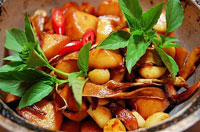 3/4 lb (350 g) fresh winter bamboo shoots
2 1/2 oz (75 g) xuelihong (preserved mustard green)
1 1/2 cups (350 ml) vegetable oil for deep-frying; uses
about 2 oz (60 ml)
1/2 tsp MSG (optional) * You can find popular Chinese cooking ingredients and cookware at ChineseFoodDIY online store at:
http://www.chinesefooddiy.com/shopping.htm
Directions:
1. Remove the husks from the bamboo shoots. Roll-cut into
diamond-shaped chunks. Soak xuelihong in water for 5 minutes to reduce its saltiness. Squeeze out the excess water and cut into 1 1/2 inch (3.5 cm) pieces.
2. Heat the oil in a wok to about 400oF(205oC), or until a
piece of scallion green or ginger browns quickly when tossed
into the oil and a haze rises above the oil surface. Add
xuelihong and deep-fry for 30 seconds. Remove and drain. Add the bamboo shoots and turn the heat to low. Deep-fry the bamboo shoots for 30 seconds, then raise the heat to high and deep-fry for 3 minutes, or until brown outside and tender inside. Remove and drain. Return xuelihong to the oil and deep-fry for 5 minutes. Remove and drain.
3. Pour all the oil out of the wok. Add xuelihong and bamboo
shoots. Stir-fry to blend, then sprinkle with the MSG. Remove and serve.
Recipes in this newsletter are from Nicholas Zhou's bestselling cookbook "Real and Healthy Chinese Cooking". 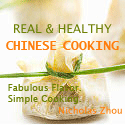
http://www.chinesefooddiy.com/cookbooks.htm
Tomato Egg Drop Soup
This recipe is the same as for Egg Drop Soup, except that
I have added two tomatoes cut into 6 equal pieces, and sugar to balance the sour tomato taste. Western versions often add cornstarch and vegetables; I've included a few
variations below.
Serves 2 - 4
Ingredients: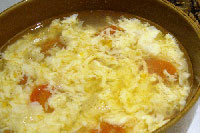
4 cups chicken broth or homemade stock
2 tomatoes, cut into 6 equal pieces
2 eggs, lightly beaten
1 -2 green onions, cut diagonally into thirds
1/4 teaspoon white pepper
1 tablespoon sugar
Salt to taste
Directions:
In a wok or saucepan, bring the 4 cups of chicken broth to
a boil. Add the tomatoes, sugar, white pepper, and salt.
Cook for about one more minute. Very slowly pour in the eggs
in a steady stream. Use a fork to gently stir the eggs in a
clockwise direction until they form thin streams or ribbons.
Garnish with green onion and serve hot.
Variations:
(These would all be added after the tomato and seasonings.
Let the soup cook for a few more minutes before adding the
eggs).
*1 teaspoon of cornstarch mixed with 2 teaspoons of water.
Stir to thicken.
**1/2 cup frozen peas.
**If you are preparing the soup for someone who is ill, try
adding a slice of fresh, grated ginger. Among its many
benefits, ginger is believed to be helpful in treating colds
and flue.
Shrimp Balls
Makes 30 to 32 balls Ingredients: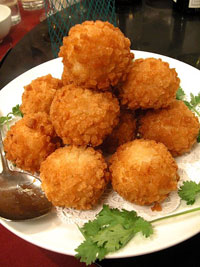
2/3 pound medium shrimp, peeled, scored down the back,
deveined, rinsed, and patted dry
1/2 cup water chestnuts, blanched in boiling water for 10
seconds, refreshed in cold water, drained, and
patted dry
- Shrimp Ball Seasonings:
1 1/2 tablespoons minced fresh ginger
1 1/2 tablespoons minced scallions
1 1/2 tablespoons Chinese rice wine or sake
1 teaspoon toasted sesame oil
3/4 teaspoon salt
1 large egg, lightly beaten
2 tablespoons cornstarch
1/4 pound thin rice stick noodles (vermicelli)
Safflower or corn oil for deep-frying
Plum or duck sauce and hot mustard for dipping
Directions:
1. In a food processor fitted with a steel blade, process
the shrimp to a paste. Transfer to a large bowl: add the
water chestnuts, seasonings, egg white, and cornstarch.
Stir vigorously until a stiff paste forms. Chill thoroughly.
2. With a towel draped over the hand that holds a sharp
knife, cut the noodles into 1/2-inch lengths. The towel
prevents the noodles from flying around. Spread evenly on a
cookie sheet.
3. Shape scant teaspoonfuls of the shrimp mixture into balls,
then roll in the noodle pieces, pressing lightly to coat.
Set on a cookie sheet.
4. Heat a wok or a deep skillet or saucepan over high. Add
the oil and heat to 375 degrees F. Deep-fry the shrimp
balls in batches, turning them constantly, until golden
brown, 3 to 4 minutes. Remove with a handled strainer or a
slotted spoon, drain briefly in a colander, then transfer
to paper towels. Between batches, skim the oil with a fine
strainer, and reheat until hot. Serve the shrimp balls warm
with sauce and mustard. To reheat, warm on a cookie sheet
in a 375 degree F. oven, about 10 minutes.
Cooking Tip: Useful Tools in Chinese Cooking
Wok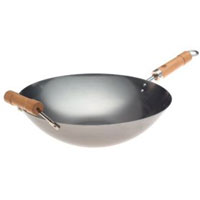
Much Chinese cooking requires the use of a wok. The wok is
traditionally made of cast iron, but is normally found in
carbon steel form in the United States. Several factors
should be kept in mind when choosing a wok, one of which is
weight. Although the wok is not generally moved around very
much on the stove, weight does play a role in a wok's
utility; a wok that is too thick will not heat as quickly
as a thinner one. More important than weight, however, is
size, and the best woks are generally 14 inches wide, large
enough to hold a whole chicken, fish or duck, and with
enough room for additional ingredients. There should be room
in the wok to move the food around, and since the heat is
concentrated on the bottom, a larger wok will allow more
food to be cooked at one time. Woks generally come with a
matching ring and cover, and be sure to look for one with
wooden handles which won't conduct heat like metal will,
making your wok easier to work with in the long run.
Cleaver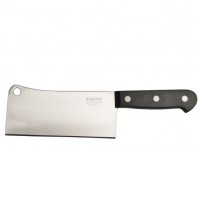
Because they retain their sharpness well and are less
expensive than stainless steel, Chinese chefs recommend
using carbon steel cleavers. Cleavers come in a variety of
weights, with each dictating its degree of usefulness.
Light-weight cleavers have narrow blades and are primarily
used for light chopping, delicate slicing and boning.
Medium-weight cleavers, which are the most versatile, have
thicker blades and are useful for all but the heaviest of
tasks. This all-purpose tool can be used for everything
from crushing ingredients to chopping, slicing, mincing and
cutting up meat.
Lastly, heavy-weight cleavers have the thickest blades and
are generally used to hack through bones and cut through
the toughest of ingredients.
Frying Strainer 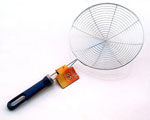
Used for deep-frying foods, the best frying strainers are made from wire mesh. Choose a strainer with long bamboo handles which won't conduct heat and will be easier to use. Wide-Blade Spatula 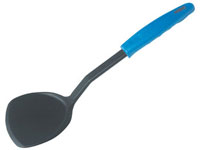
This tool is helpful when stir frying and scooping up food.
Its long handle helps keep you farther away from cooking
heat.
Ladle or Scoop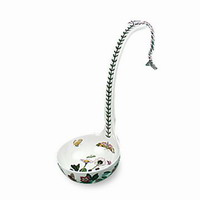
This dual-purpose tool is used for removing food from the
wok. The ladle or scoop can also be used to impress your
friends, allowing you to mix sauces right over the wok.
Of course, this technique takes practice, so be sure to
rehearse before performing in front of an audience!
Long Wooden Chopsticks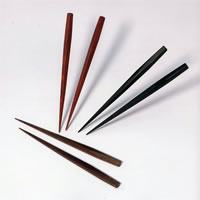
Do I need to mention this here? Well, just in case. Chopsticks are useful for picking up and moving food around within the wok, but only if you know how to use them! Here again, the wood will not get hot, making them easy to work with.
Bamboo Steamer with Lid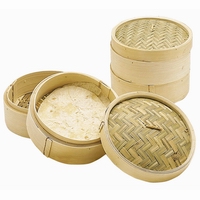
This fundamental tool is designed to fit inside the wok,
and can be used one at a time or stacked one on top of
another. You may line the steamer with cheesecloth and
place food on top of it for cooking, or simply place the
steamer onto plates when serving. The steamer should sit
approximately one inch above the boiling water inside the
wok, and the water should be replaced as it evaporates
during cooking. When cleaning the steamer, be sure to avoid
using detergent -- the bamboo will absorb the flavor of the
soap, so instead simply rinse with water.
More cooking tips are available as special bonus if you
order my cookbook "Real and Healthy Chinese Food Recipes".
For details, please go to:
http://www.chinesefooddiy.com
Cookingrecipes, please tell us what you think about our
website, our newsletters and our service, we are trying our
best to make your life a little bit easier, fresher, and
more tastiful.
Spread the word about ChineseFoodDIY.com now. Forward this email or recommend us to your friends at:
http://www.chinesefooddiy.com/recommend.htm
They will LOVE it. Thanks!
Cheers,
Happy cooking!

Nicholas Zhou - Author
Real and Healthy Chinese Cooking 
http://www.chinesefooddiy.com | | | | 
|

|  - Bake the Best Brownies Every Time!
- The World's First Bake, Slice and Serve Brownie Maker. Get Yours NOW! | | 
- Marinate Your Food in Just Seconds
- World's 1st instant vacuum marinator and flavor injector
| | |  - Amazing 5-in-1 Pasta Cooker - Cook, Drain and Serve All in One Get Yours NOW! | |  
 | |